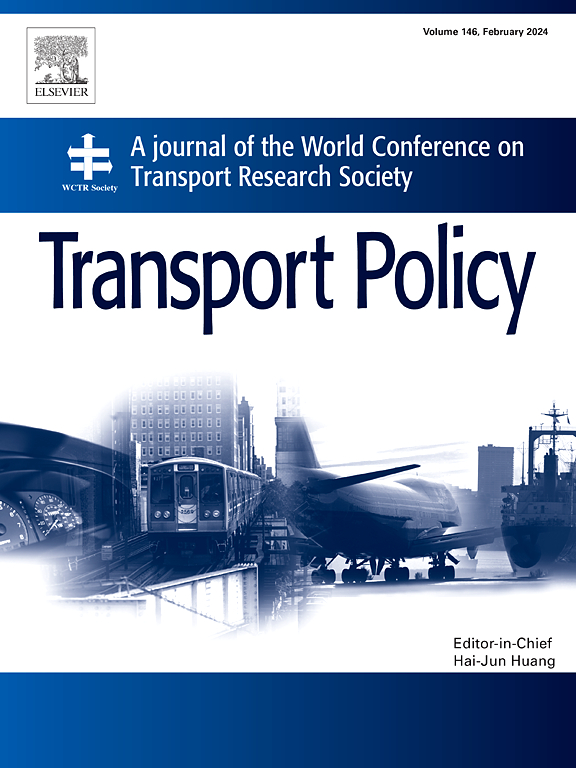Optimal spatial-temporal capacity allocation for morning commute with carpool considering parking supply constraint
IF 6.3
2区 工程技术
Q1 ECONOMICS
引用次数: 0
Abstract
Allocating urban highway capacity to prioritise carpooling traffic is a well-studied subject. However, one area of limited research so far is on the impact of parking constraint at workplace on its spatial-temporal design. This paper examines a multi-modal morning commute scenario, where commuters can freely choose solo driving, carpooling, or public transit to go to work. The highway bottleneck capacity is shared between a general-purpose lane for all drivers and a time-limited carpool lane for carpooling vehicles only. Analytical derivations of all possible commute patterns are provided, considering different parking supply levels and capacity allocation strategy. Results show that all bottleneck capacity should be allocated to carpool lane spatially, but the optimal temporal allocation of carpool lane may not be unique for minimizing total trip cost. This implies, the accurate estimation of extra carpool cost to optimize the temporal lane reservation may be no longer necessary for the traffic authority due to the limited parking supply, whilst it is really required when the parking supply is abundant. We also incorporate the traffic authority's social cost budget for both temporal and spatial allocations into the optimization problem, explaining why general-purpose lanes are still prevalent in reality. The research has implications on policy makers as well as workplace parking managers by providing them a framework to design optimized road-space allocation with workplace parking supply.
考虑车位供给约束的拼车早通勤最优时空容量分配
分配城市公路容量以优先考虑拼车交通是一个研究得很透彻的课题。然而,迄今为止,关于工作场所停车限制对其时空设计影响的研究还很有限。本文研究了一个多模式的早晨通勤情景,通勤者可以自由选择独自驾车、拼车或乘坐公共交通上班。高速公路的瓶颈容量由一条供所有驾驶员使用的通用车道和一条只供拼车车辆使用的有时间限制的拼车车道共享。考虑到不同的停车位供应水平和容量分配策略,对所有可能的通勤模式进行了分析推导。结果表明,所有瓶颈容量都应在空间上分配给拼车车道,但拼车车道的最佳时间分配可能不是唯一的,无法使总出行成本最小化。这意味着,在停车位供应有限的情况下,交通管理部门可能不再需要通过准确估算额外的拼车成本来优化时间车道预留,而在停车位供应充足的情况下,则需要这样做。我们还将交通管理部门在时间和空间分配方面的社会成本预算纳入优化问题,从而解释了为什么通用车道在现实中仍然普遍存在。这项研究为政策制定者和工作场所停车场管理者提供了一个框架,使他们能够根据工作场所停车场的供应情况来设计优化的道路空间分配,从而对他们产生影响。
本文章由计算机程序翻译,如有差异,请以英文原文为准。
求助全文
约1分钟内获得全文
求助全文
来源期刊

Transport Policy
Multiple-
CiteScore
12.10
自引率
10.30%
发文量
282
期刊介绍:
Transport Policy is an international journal aimed at bridging the gap between theory and practice in transport. Its subject areas reflect the concerns of policymakers in government, industry, voluntary organisations and the public at large, providing independent, original and rigorous analysis to understand how policy decisions have been taken, monitor their effects, and suggest how they may be improved. The journal treats the transport sector comprehensively, and in the context of other sectors including energy, housing, industry and planning. All modes are covered: land, sea and air; road and rail; public and private; motorised and non-motorised; passenger and freight.
 求助内容:
求助内容: 应助结果提醒方式:
应助结果提醒方式:


